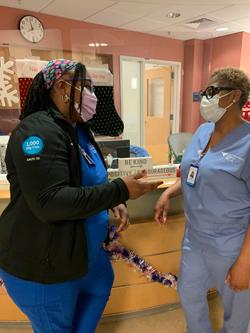
Popular Locations
- Yale New Haven Children's Hospital
- Yale New Haven Hospital - York Street Campus
- Yale New Haven Hospital - Saint Raphael Campus


Caption: Nicole Bowers-Gulley, RN, Medicine (NP 1), recently explained YNHHS’ Patient Bedside Rounding Program to Timika Ledbetter-Hicks, patient care associate, Medical ICU. Bowers-Gulley is a trainer for the program, which teaches staff to connect with patients to improve their care, safety and experience.
The techniques Nicole Bowers-Gulley, RN, is teaching fellow staff members are not new.
They include how to introduce yourself to patients, be an active listener, watch for patients’ non-verbal cues and follow through on patients’ requests.
Bowers-Gulley is a trainer with Yale New Haven Health System’s Patient Bedside Rounding (PBR) program. The program launched last year and is currently operating in most patient care areas at Bridgeport, Greenwich, Lawrence + Memorial and Yale New Haven hospitals. Other areas will implement it in the next couple months.
PBR builds on current rounding practice and aligns with communication behaviors taught in the Enhancing Relationship-Centered Communication course available to YNHHS staff on the YNHHS Learning Management System. These behaviors focus on treating others with courtesy and respect, listening carefully and explaining things in a way patients can understand.
Research has shown that consistent rounding improves patient outcomes, quality and safety and staff productivity, in addition to the patient experience, said Thomas Balcezak, MD, YNHHS chief clinical officer.
“Patient Bedside Rounding is a structured, evidence-based, patient-centric way to connect with patients and loved ones,” said Tina Bennett, YNHHS chief experience officer. “It is an important part of the health system’s Care Signature.”
PBR goals are to:
PBR is also designed to enhance efficiency in care delivery.
“This work does not take more time; it actually saves us time because we are proactively anticipating and addressing patient needs,” said Ena Williams, RN, PhD, YNHH chief nursing officer. “I am proud of what we have accomplished and committed to continuing this great work.”
While some program elements focus on unit staff, PBR is for everyone who interacts with patients, including employees with Nursing, Environmental Services, Food and Nutrition, Patient Transport, Respiratory Therapy, Rehabilitation Services, Laboratory, Patient Relations, Pharmacy, Care Management and Language Services, along with volunteers.
PBR includes four major components: Connect, check, collect and commit. Each component has certain behaviors or activities associated with it. For example, connect includes active listening and minimizing distractions. Check includes scanning the environment to assess and address safety and clinical needs. Collect includes inviting questions and concerns and implementing service recovery. Commit includes telling patients what you will do to follow up on issues and following through.
Many of these techniques have been used at Yale New Haven Hospital for years, but PBR provides reminders for longer-term staff, and is particularly helpful for new employees, said Adam Brothers, RN, assistant patient services manager, Medicine (EP 4-6).
“We encourage staff to spend five minutes with new patients at the start,” said Rose Vaccaro, RN, EP 4-6 patient services manager. “It helps build a trusting relationship and gives patients confidence that we’re going to take good care of them.”
“We’re really getting back to the basics,” Bowers-Gulley said. “This is about finding the best ways to connect with patients, to really hear what they are saying.”
A Patient and Family Advisory Committee member noted, “Out of all the work you plan to do, connecting with patients on a consistent basis is most impactful to improving patient satisfaction.”
To enroll in a PBR class, visit the Learning Management System on Infor and choose a live virtual class or e-learning. For more information, email [email protected].